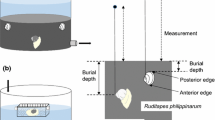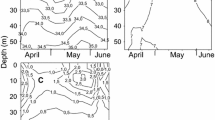Summary
The effect of a predatory leech, Nephelopsis obscura, on survivorship, growth, and production of chronomid larvae was studied by enclosure experiments carried out in a small pond. The prey population was composed almost entirely of the tubiculous, microphagous chironomid larvae, Chironomus riparius and Glyptotendipes paripes. Nephelopsis significantly reduced chironomid survivorship within the enclosures, and accounted for most of the measured mortality of fourth instar larvae. The cropping by Nephelopsis was not significantly biased toward either prey species. In long-term experiments (66 d) chironomid biomass in enclosures without leeches reached much higher levels than in enclosures containing Nephelopsis. This increase in biomass was due to growth of surviving larvae, rather than recruitment, since emergence and oviposition were not going on during the course of the experiments. The enhanced survivorship of larvae within leech-free enclosures was eventually accompanied by reduced growth and specific production (daily production/biomass) for C. riparius, which made up about 90% of the larval population. Growth and specific production of G. paripes (10% of larval population) was not affected. Short-term experiments (25 d) involving manipulation of densities and species ratio (9:1 CR:GP and 1:9 CR:GP) of larvae revealed that growth of the majority species was strongly influenced by larval density, whereas growth of the minority species was not. The same pattern was observed both in the presence and in the absence of Nephelopsis and was a result of differences in resource utilization between the two species. In the shortterm experiments, growth rates estimated for larvae exposed to leeches were significantly less than those for larvae in leech-free enclosures. This could be due either to size-biased consumption of larvae by Nephelopsis, or possibly a disturbance factor leading to reduced larval food intake and/or increased metabolic costs.
Similar content being viewed by others
References
Anholt B (1986) Prey selection by the predatory leech Nephelopsis obscura in relation to three alternative models of foraging. Can J Zool 64:649–655
Benke AC (1976) Dragonfly production and prey turnover. Ecology 57:915–922
Benke AC (1978) Interactions among coexisting predators—a field experiment with dragonfly larvae. J Anim Ecol 47:335–350
Chesson J (1978) Measuring preference in selective predation. Ecology 59:211–215
Crowder LB, Cooper WE (1982) Habitat structural complexity and interactions between bluegills and their prey. Ecology 63:1802–1913
Davies RW, Wrona FJ, Everett RP (1978) A serological study of prey selection by Nephelopsis obscura Verrill (Hirudinoidea). Can J Zool 56:587–591
Hall DJ, Cooper WE, Werner EE (1970) An experimental approach to the production dynamics and structure of freshwater animal communities. Limnol Oceanogr 15:839–938
Hayne DW, Ball RC (1956) Benthic productivity as influenced by fish predation. Limnol Oceanogr 1:162–175
Hilsenhoff WL (1963) Predation by the leech Helobdella stagnalis on Tendipes plumosus (Diptera: Tendipedidae) larvae. Ann Ent Soc. America 56:252–261
Kajak Z (1972) Analysis of the influence of fish on the benthos by the method of enclosures. pp 781–793 in Kajak Z, Hillbricht-Ilkowska A (eds) Productivity Problems of Freshwaters. Warsaw, PWN Polish Scientific Publishers
Morin PJ (1984a) The impact to fish exclusion on the abundance and species composition of larval odonates: Results of shortterm experiments in a North Carolina farm pond. Ecology 65:53–60
Morin PJ (1984b) Odonate guild composition: experiments with colonization history and fish predation. Ecology 65:1866–1282
Peckarsky BL, Dodson SI (1980) Do stonefly predators influence benthic distributions in streams? Ecology 61:1275–1282
Rasmussen JB (1983) An experimental analysis of competition and predation, and their effects on growth and coexistence of chironomid larvae in a small pond. PhD thesis University of Calgary, Calgary, Alberta, p 220
Rasmussen JB (1984a) The life-history, distribution and production of Chironomus riparius and Glyptotendipes paripes in a prairie pond. Hydrobiologia 119:65–72
Rasmussen JB (1984b) Comparison of gut contents and assimilation efficiency of the fourth instar larvae of two coexisting benthic chironomidae, Chironomus riparius Meigen and Glpytotendipes paripes (Edwards). Can J Zool 62:1022–1026
Rasmussen JB (1985) Effects of density and microdetritus enrichment on the growth of chironomid larvae in a small pond. Can J Fish Aquat Sci 42:1418–1422
Sih A, Crowley P, McPeek M, Petranka J, Strohmeier K (1985) Predation, competition, and prey communities: a review of field experiments. Ann Rev Ecol Syst 16:269–311
Strickland JDH, Parsons TR (1972) A manual of sea water analysis. Bull Fish Res Bd Can No 125, p 186
Welch EB, Ball RC (1966) Food consumption and production of pond fish. J Wildlife Mgmt 30:527–536
Winberg GC (1971) Methods for the estimation of production of aquatic animals. Duncan A (Transl) Academic Press, London
Zaika VE (1973) Specific production of aquatic invertebrates. Wiley, New York/Israel Program of Scientific Translations. Jerusalem, Israel
Zar JH (1974) Biostatistical analysis. Prentice-Hall, Toronto
Author information
Authors and Affiliations
Rights and permissions
About this article
Cite this article
Rasmussen, J.B. The effect of a predatory leech, Nephelopsis obscura, on mortality, growth, and production of chironomid larvae in a small pond. Oecologia 73, 133–138 (1987). https://doi.org/10.1007/BF00376989
Received:
Issue Date:
DOI: https://doi.org/10.1007/BF00376989




